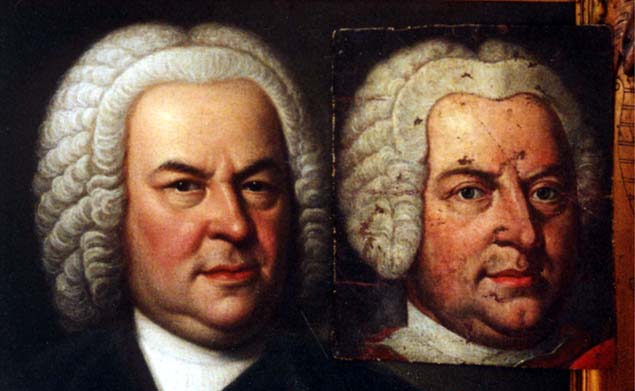The Critical Discographies from Choral Music On Records - Mass in B Minor Pages at the Teri Noel Towe Home Pages
Johann Sebastian Bach
The Critical Discographies from Choral Music On Records
This remarkable photograph is not a computer generated composite; the original of the Weydenhammer Portrait Fragment, all that
remains of the portrait of Johann Sebastian Bach that belonged to his pupil Johann Christian Kittel, is resting gently on the surface
of the original of the 1748 Elias Gottlob Haussmann Portrait of Johann Sebastian Bach.

1748 Elias Gottlob Haussmann Portrait, Courtesy of William H. Scheide, Princeton, New Jersey
Weydenhammer Portrait Fragment, ca. 1733, Artist Unknown, Courtesy of the Weydenhammer Descendants
Photograph by Teri Noel Towe
©Teri Noel Towe, 2001, All Rights Reserved
The Critical Discographies from Choral Music On Records
Mass in B Minor, BWV 232
Mass in B Minor, BWV 232
The Recordings in the Neo-Baroque Leipzig Style
The second of the 1950 commemorative performances to be released commercially is a group of excerpts from a complete
performance in the Thomaskirche in Leipzig that was issued in the West by Cantate in the early '60s. [12] Günther Ramin, then the
incumbent of the Thomascantorate that Bach had held more than two centuries before, employed large forces, including two boys'
choirs, in bringing forth his singular conception of the Mass: granitic yet not forbidding, monumental yet never stolid. A disciple of
his immediate predecessor, Karl Straube (1873-1953), who had fused the neo-Classical Mendelssohnian Bach style prevalent in
Leipzig and in Germany at the time of the First World War with both tenets of authentic performance practice and Regerian
Germanic post-Romanticism, Ramin strives for and achieves powerful and grand effects; the extreme ritard at the end of the
concluding "Dona nobis pacem", for example, is mind boggling. A recording of the complete performance exists. One hopes that it
will soon be issued in its entirety.
That the performance would be worth releasing complete is confirmed by the commercial recording that Ramin made of the Mass
shortly before he died. [13] A scrappy orchestra, a coarse chorus, by and large indifferent soloists, and the pressures of working
with unfamiliar forces under severe time constraints all apparently combined to defeat Ramin's attempt to successfully preserve his
unique and powerful interpretation on a commercial recording.
Ramin's immediate successor at the Thomaskirche, Kurt Thomas, recorded the Mass in the late '50s, shortly before he emigrated to
the West. [14] His a drab, flaccid account, leaden rather than majestic, is marred by acidulous instrumental playing. A little better is
the recording made in the late '50s by Rudolf Mauersberger, the then director of the Dresdner Kreuzchor - one of the two boys'
choirs that participated in Ramin's 1950 performance in the Thomaskirche. [15] The choruses are crisply sung, with chiseled
articulation, by the well trained choir, and the solo quartet is both sensitive and well matched, but the performance as a whole
sounds clinical and lacks both warmth and subtlety.
The harpsichord continuo in the 1950 Ramin performance was played by Karl Richter, who, like Kurt Thomas, settled in the West.
In 1961, with his 90 voice Munich Bach Choir and Orchestra and a stellar solo quintet, Richter made the quintessential recording of
the Mass in the "modern" neo-Baroque Leipzig style. [16] Now three decades old, this extraordinary performance remains
unchallenged as the recording of choice for those who want a "modern" reading of the work that is at the same time mindful of
stylistic issues. Richter's charismatic, passionate, incisive, and pulse quickening reading is the logical extension of the Ramin
approach, but it is more polished, less rough hewn. This vividly recorded account remains the paradigm against which all "modern
instrument" performances of the Mass in B Minor must be measured.
Several years ago, as a memorial to Karl Richter, Deutsche Grammophon Archiv issued, in Japan only, a recording of a
performance of the Mass that Richter had given in Tokyo in 1969 while on tour with the Munich Bach Choir. [17] Cut off of the
same bolt of interpretative cloth as the studio recording, this fascinating document does not, however, quite measure up to its
precursor either sonically or technically. Both the recording and the television film of the Mass that Richter made in the early '70s
(Will that performance, recorded in a magnificent Baroque pilgrimage church in Bavaria, never appear on video cassette or video
disc?) show, however, show not only that he adhered to his interpretation throughout his career but also that he never became glib
or facile. The interpretation always sounds fresh.
Richter, by the way, is one of the handful of conductors who elected not to follow the text of the Friedrich Smend's scholarly
edition of the Mass, published by the Neue Bach Ausgabe in 1955, in one important particular. The autograph does not specify the
obligato instrument in the "Benedictus". The Bach Gesellschaft edition and all other editions prior to that published by the NBA
give the part to the violin. Smend shows convincingly that, on the basis of its compass and the absence of double stops, this
instrumental solo was meant for the flute. Richter and a few others, like Herbert von Karajan, stuck by the violin through
interpretative thick and scholarly thin. Unless specified to the contrary, however, the reader may assume that for all recordings made
after the appearance of the Neue Bach Ausgabe Edition, the obligato in the "Benedictus" is assigned, "correctly", to the flute.
For many, the inheritor of Karl Richter's mantle as the great interpreter of the Bach sacred vocal music in the "modern" German
neo-Baroque tradition is Helmuth Rilling. With his Gächinger Kantorei Stuttgart, he has recorded the B Minor Mass twice. Of the
two sets, the first, which was published in 1977, is far and away the better. [18] Often searingly clear but never clinical choral
singing and instrumental playing and exemplary contributions from the five soloists are the most important hallmarks of this
interpretation. Rilling's tempos are brisk but never overly so, and the interpretation has a grandeur and an incisiveness that evokes
Richter's.
In the second half, at least, Rilling's 1988 recording of the Mass has many of the same qualities as his first. [19] His choice of
brisker tempos in the "Gloria", particularly, has resulted in an interpretation that sounds oddly glib and facile; it lacks the profundity
and incisiveness so much in evidence in the earlier account. While commendable, the soloists are not, with the exception of tenor
Howard Crook, up to the same high standard set by those in the 1977 recording.
Rilling's were not the first recordings of the Mass to be made by a Stuttgart ensemble. In 1971, Karl Münchinger, the founder of the
Stuttgart Chamber Orchestra, committed his interpretation of the work to disc. [20] It is much in the same vein as the Ramin,
Richter, and Rilling accounts; in the high neo-Baroque German style, the reading is warm and earnest, solid but always plastic. the
chorus, however, is muddy sounding from time to time, and there are some patches of gamey intonation. There are five first rate
soloists, including two sopranos, so Elly Ameling, who sings the first soprano part with great beauty, did not have to worry about
being the first to look at the conductor at the first rehearsal for the "Laudamus te".
The most recent of the neo-Baroque "modern" instrument accounts in the Straube-Ramin vein to emanate from the German
Democratic Republic is Peter Schreier's, recorded in 1981-1982. [21] Schreier unfortunately allowed himself to be seduced by
some of the musicological fads that were voguish in the '70s. He often stresses strong beats with swells and sforzandi, and he
assigns the corno da caccia obligato in the "Quoniam" to a curious modern hybrid brass instrument of the same name that was
invented to respond to some highly dubious "findings" that purportedly "proved" that the corno da caccia part in the Mass was
meant to be transposed up, rather than down. Ludwig Güttler plays the part superbly on this bastard brass instrument, but for the
discerning listener the obtrusiveness of the repeated "pedal" tones as played "up" rather than "down" and the failure of the
instrument to blend at all with the two bassoons, effectively puts the kibosh on the purported "authentic" new "old" brass
instrument. On the plus side are a fine group of soloists, just tempos, and enthusiastic singing and playing from chorus and
orchestra alike.
Please click here to advance to Page 6 - The 1950s
Please click here to visit the Endnotes Page.
Please click here to visit the Alphabetical Discography Page.
Please click here to return to the Critical Discographies from Choral Music On Records Main Page.
Please click on  to return to the Johann Sebastian Bach Index Page.
to return to the Johann Sebastian Bach Index Page.
Please click on the  to return to the Teri Noel Towe Welcome Page.
to return to the Teri Noel Towe Welcome Page.
teritowe@alumni.Princeton.EDU
Copyright, Teri Noel Towe, 1989, 1997, 2001
All Rights Reserved
The The Critical Discographies from Choral Music On Records - Mass in B Minor Pages at the Teri Noel Towe Home Pages
are PPP Free web pages.

The The Critical Discographies from Choral Music On Records - Mass in B Minor Pages at the Teri Noel Towe Home Pages
have received the HIP Woolly Mammoth Stamp of Approval from The HIP-ocrisy Home Page.